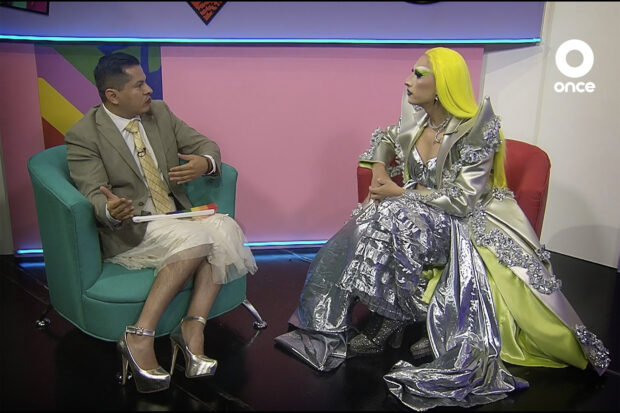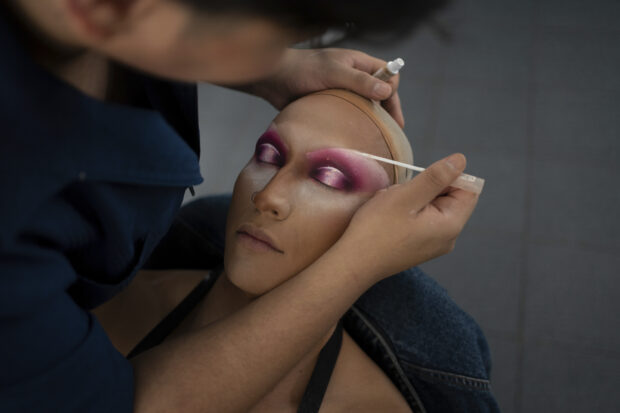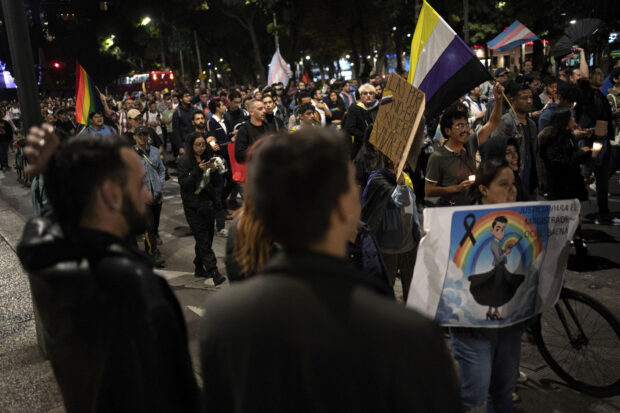Meet the newscaster in drag making LGBTQ+ history on Mexican TV

Journalist Guillermo Barraza is making history on television as he delivers news in drag in Mexico, where both LGBTQ+ people and journalists are violently targeted. In this frame grab taken from video provided by Canal Once, Amanda, right, the first-ever drag queen to host a news program for Mexican TV, interviews magistrate Ociel Baena, the first openly nonbinary person in Latin America to hold a judicial position, on the “La Verdrag” news program, in Mexico City, Thursday, October 26, 2023. Baena was found dead on Nov. 13, 2023, next to their partner in their home in the central Mexican state of Aguascalientes.(Canal Once via AP)
MEXICO CITY — Guillermo Barraza buzzed with a nervous energy as he watched himself transform.
Hands delicately painted stripes of bright pink eyeshadow onto Barraza’s angular face as newscasters and makeup crews bustled around him.
In a small studio set in the heart of Mexico City, Barraza made history.
Through his drag character Amanda, the 32-year-old journalist was the first-ever drag queen to host a news program for Mexican TV.
By stepping out under the glow of the studio lights, Barraza has sought to push the boundaries of society in a place where both LGBTQ+ people and journalists are violently targeted. And he is doing it at a moment when the issue has roared back into the public discourse with the violent death of one of the very guests on his program, one of the most prominent queer figures in the country who was later found dead along with their partner with dozens of cuts across their body.
Article continues after this advertisement“Having an alter ego, you have fewer problems because they can’t harass a character. You have more freedom to speak out,” he said. “There are many things that Guillermo wouldn’t do or say that Amanda wouldn’t think twice about.”
Article continues after this advertisementREAD: ‘Drag Den Philippines’ Season 2 aims to be ‘accessible’ for Filipino drag artists
As he said it, his makeup artist helped him pull on a bright blonde wig, and Barraza shrugged on a purple sequined blazer. Each piece went on like another layer of sparkle-studded armor until all that remained of Barraza was a playful smile under purple lipstick.
“Let’s go, let’s go,” Barraza said, striding through the halls, each clack of his leather boots ringing out like an act of defiance to a society that has long rejected people like him.
“Rock star,” he added, pushing through the heavy metal doors and onto his set.

A makeup-artist builds drag eyes on news anchor Guillermo Barraza as he is transformed into his drag character Amanda in preparation for the pre-taping of his program “La Verdrag”, at the Canal Once studio in Mexico City, Wednesday, October 11, 2023. Barraza, a journalist of 10 years, took the helm of the newscast of his public television station, Canal Once, during Mexico’s Pride celebration in June dressed in drag. (AP Photo/Aurea Del Rosario)
From its inception, the program “La Verdrag” was meant to radically transform the way the LGBTQ+ community is viewed in Mexican society. First broadcast in October, the program goes against the grain in a highly “macho” country where nearly 4 in every 5 people identify as Catholic.
The program – a play on words in Spanish mixing the word “truth” and “drag” – first came to fruition when Barraza, a journalist of 10 years, took the helm of the newscast of his public television station, Canal Once, during Mexico’s Pride celebration in June dressed in drag.
The crush of hate comments that followed first scared Barraza, who had already received two death threats working as a journalist in northern Mexico. But it soon pushed him and the TV station to create a show to make a space to discuss LGBTQ+ issues with a serious tone.
“This just years ago, would be completely unthinkable, talking about transsexuality, gender, drag,” said Vianey Fernández, a news director at Canal Once. “We want to open up spaces for the LGBTQ+ community, and we need to do it with a serious perspective, recognizing not just their rights but also their abilities.”
READ: LGBTQ fears grow in Malaysia as Islamists shatter reform hopes
In Mexico, drag – the act of dressing up in exaggerated outfits that challenge gender stereotypes – has been long employed in entertainment and comedy shows like “El Show de Francis,” “Las Hermanas Vampiras” and “Desde Gayola.”
The shows would often use gay slurs and cartoon-like stereotypes. Still, they took key steps in carving out space for the queer community in Mexico, said Jair Martínez, researcher for the Mexican LGBTQ+ rights organization Letra S.
“They’re pioneers, showing how you can transform yourself from a victim to someone with agency, with the capacity to resist,” he said.
Growing up gay in the conservative northern city of Culiacán, Sinaloa, Barraza never saw gay characters he identified with on a deeper level staring back at him from the screen of his family’s clunky television.
On news channels, the only time gay people were brought up was following a hate crime or a brutal murder. In school, people would go out of their way to not appear gay. With a family that continues to struggle to accept his public gender expression, Barraza said he only grew into himself when he became involved in a theater community, where his character of Amanda was born.
“In Sinaloa, they teach you not to be gay.” Barraza said. “Historically, we were always ridiculed, an object of entertainment.”
In other countries, with the rise of shows like “RuPaul’s Drag Race,” drag has gradually mixed with mainstream culture. But drag has long been used as a tool or resistance when the LGBTQ+ community is “under attack”, explained Michael Moncrieff, a University of Geneva researcher who has studied the history of drag queens.
Early examples date back to 18th century England’s “molly houses,” secret meeting places where people would cross dress and which were often raided by authorities when homosexuality was still a capital offense. Later, drag would become an integral part of the so-called Harlem Renaissance, and the faces of resistance in key moments like the McCarthy-era.
In the past 15 years, the practice has rippled across the world from Israel to Moscow to parts of Africa, Moncrieff said, and continues to be used in the U.S. to combat a wave of anti-LGBTQ+ legislation and bans.
“These are the fighters of their community,” Moncrieff said. “Drag queens were willing to do the things that no one else wanted to do.”

Video feeds of the pre-taping of the news program “La Verdrag” and drag queen anchor Amanda, are tracked on a monitor wall in the Canal Once studio control room, in Mexico City, Wednesday, October 11, 2023. The program’s name is a play on words in Spanish mixing the word “truth” and “drag”. (AP Photo/Aurea Del Rosario)
Barraza opened his program with a characteristic flourish, standing on a stage surrounded by three hefty broadcast cameras and earpiece-donning producers counting down “four, three, two, one.”
Today, wrapped in a puffy blue-and-purple ball gown, Barraza spinned around, looks into the camera with his chin tilted upward and said: “Welcome to La Verdrag, the program where minorities turn into a majority.”
Running 40 minutes in length, Barraza’s showed cycles through the day’s biggest headlines – gender in Mexico’s 2024 elections, human rights in a historic migration to the US, and violence against queer populations. He pivoted the rest of the program to deeply reported stories and interviews that each pull back a different layer of the world of queerness in Mexico.
One week, it’s a deep dive on transgender youth in Mexico, the next it’s an interview with Ociel Baena, the first openly nonbinary person in Latin America to hold a judicial position. One of most recognizable LGBTQ+ figures in the country, Baena smashed through barrier after barrier, becoming emblematic of the fight for visibility long championed by drag queens of the past.
“This hate speech against me continues to grow and grow. I’ve seen it on social media. What’s most regrettable are the death threats I’ve been receiving recently,” Baena said. “They’re ingredients that create a breeding ground for homicides.”
READ: Drag queens called in by school to address bullying of LGBT kids
Donning a blazer, silver pumps shrouded by a white skirt, and their signature rainbow fan, it would be the last TV interview the magistrate would ever give. Just weeks later, Barraza would be reminded that breaking out of that box in a place like Mexico can come with deadly consequences.
Baena was found dead next to their partner in their home in the conservative central Mexican state of Aguascalientes. What appeared to be nearly two dozen razor cuts slashed across their body, haunting Barraza and many queer people in Mexico.
Just hours after Baena’s body was found, local prosecutors quickly described the deaths as a murder-suicide, a move often made by authorities to dub a case a crime of passion and quickly shelve cases in a country where nearly 99% of crimes go unsolved.
Local prosecutors said it appeared that Baena’s partner had killed the magistrate then killed himself, a theory quickly rejected by other Mexican officials and Mexico’s LGBTQ+ community, which said it was just another attempt by authorities to brush aside the violence against them.
Activists continue to demand a deeper investigation, taking into account the mounting death threats against Baena and historical violence against LGBTQ+ populations. In the first month of 2024, authorities and rights groups registered at least three more transgender people killed.

News anchor Guillermo Barraza, foreground, and his partner Francisco, join in a protest demanding justice over the death of Ociel Baena, the first openly nonbinary person in Latin America to hold a judicial position, in Mexico City, Monday, November 13, 2023. “In this country, no one is safe,” Barraza said. “The more visible you are, the more you want to fight for change, the more you put a target on your own chest. And if we have to put our lives on the line, that’s what we’ll do, because we won’t let fear win.” (AP Photo/Aurea Del Rosario)
Gathered with a group of friends in his Mexico City apartment after watching the first broadcast of “La Verdrag,” Barraza flicked through rows of hate comments flooding Canal Once’s social media, something that would only continue to grow with each broadcast.
“‘God prohibits perversion, only Satan is happy with the rotting of this world. What a disgusting creep,’” Barraza read with a roar of laughter, tossing out jokes with his characteristic ease.
Behind it is a blanket of fear, a reminder of the weight of what he’s undertaking.
In addition to being one of the deadliest places to practice journalism in the world, Mexico has some of the highest rates of violence against LGBTQ+ communities in Latin America, a region where hate crimes and gender-based violence already run high.
“I wouldn’t be the first journalist to be killed and I wouldn’t be the last,” he said. “My biggest fear is that what I’m doing is going to hurt other people, my partner, my mom, my brother.”
Over the past six years, the rights group Letra S has documented at least 513 targeted killings of LGBTQ+ people in Mexico. Cases of violence have only risen in the past year, said Martínez, the Letra S researcher tracking the deaths.
Slayings of gay and transgender people are often characterized by a particular brand of brutality, bodies left mutilated by their victimizers. While a normal homicide victim in Mexico may be stabbed once and show signs of beatings, Martínez said he’s seen cases of gay people being stabbed up to 20 times, their genitals cut off and hate messages written across their bodies.
“They don’t just try to put an end to the victim, but rather send a message to the entire population. This brutality is intended to sort of discipline or to make an example of what could happen to other LGBTQ+ people,” Martínez said.
READ: Drag queen charged for viral ‘Ama Namin’ video
Barraza peered down at a sea of thousands of mourners carrying candles and Pride flags in mid-November, a somberness painted on his normally animated face.
Speckling nearly every surface are photos of the magistrate Baena, who just weeks before sat across from Barraza speaking about mounting death threats they received for their activism.
Their violent death sent shockwaves through Mexico’s gay community, that once looked to Baena as a vocal leader in their fight for visibility. Chants of “justice, justice!” floated over Barraza, whose mind cycled through the hate comments popping up on La Verdrag’s social media.
“They’re both sick in the head,” read one. “Divine justice.”
“One week drunk celebrating their killing, the world is a better place,” another would read.
He saw flashes of Baena smiling and laughing next to him behind the cameras of his studio.
“My mom wrote to me this morning incredibly worried. A couple friends wrote to me saying, ‘Man, step out of the spotlight. Don’t talk politics. Protect yourself,’” Barraza said. “I don’t want my mom to have to be the one out here marching.”
As Barraza marched alongside thousands of others winding through Mexico City’s main artery, tears began to stream down his face. His partner, Francisco, wrapped his arms around Barraza and they stepped forward hand-in-hand, walking until the wind whipping around them dries their tears.
“In this country, no one is safe,” Barraza said. “The more visible you are, the more you want to fight for change, the more you put a target on your own chest. And if we have to put our lives on the line, that’s what we’ll do, because we won’t let fear win.”